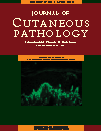Value of p63 and podoplanin (D2-40) immunoreactivity in the distinction between primary cutaneous tumors and adenocarcinomas metastatic to the skin: a clinicopathologic and immunohistochemical study of 79 cases
Abstract
The distinction of metastatic carcinomas to the skin from poorly differentiated primary cutaneous carcinomas and sometimes primary benign adnexal tumors can pose a significant diagnostic challenge. The purpose of this study was to evaluate the role of p63 and podoplanin (D2-40) immunoreactivity for separating primary skin tumors vs. cutaneous metastases of carcinomas from internal organs. Thirty seven primary tumors and 42 cutaneous metastatic adenocarcinomas were evaluated. The 37 primary cutaneous tumors included 14 cases of benign adnexal tumors, 9 malignant skin adnexal neoplasms, and 14 primary squamous and basal cell carcinomas. The 42 metastatic adenocarcinomas all corresponded to metastases from patients with a well-documented history of a primary tumor at another location. We found variable positivity with podoplanin in all primary cutaneous neoplasms including spiradenoma (6/6), hidradenoma (2/4), cylindroma (3/3), desmoplastic trichilemmoma (1/1), poorly differentiated squamous cell carcinoma (4/4), sebaceous carcinoma (1/1), basal cell carcinoma (4/10), trichilemmal carcinoma (2/2), eccrine carcinoma (3/3), microcystic adnexal carcinoma (1/1), adnexal carcinoma NOS (1/1), and porocarcinoma (1/1). In contrast, all metastatic carcinomas were negative (0/42) for podoplanin. In regards to p63, all cases of primary cutaneous tumors were positive for p63 (37/37); in contrast, all cutaneous metastatic carcinomas were negative (0/42). Sensitivity, specificity, and positive and negative predictive values of podoplanin and p63 immunoreactivity to separate primary skin neoplasms from metastatic carcinomas were 78.4, 100.0, 100.0 and 84.0% for podoplanin, respectively, and 100.0, 100.0, 100.0 and 100.0% for p63, respectively. The differences in p63 and podoplanin immunohistochemical expression between primary skin tumors and metastatic carcinomas to the skin were statistically significant (p < 0, 0001). The results of our study suggest that the combined expression of p63 and podoplanin are a useful adjunct for the diagnosis of skin tumors in the clinical setting of a questionable metastasis and may be relatively specific for distinguishing primary skin tumors from metastatic carcinomas to the skin.
Plaza JA, Ortega PF, Stockman DL, Suster S. Value of p63 and podoplanin (D2-40) immunoreactivity in the distinction between primary cutaneous tumors and adenocarcinomas metastatic to the skin: a clinicopathologic and immunohistochemical study of 79 cases.




